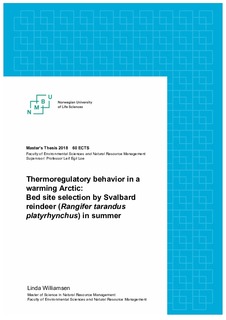| dc.description.abstract | Climate change leads to rapidly increasing mean temperatures, and the climate warming is particularly pronounced in the Arctic. In Arctic mammals with long generation times, evolution of physiological and morphological traits may not be fast enough to keep up with the rapid climate warming. However, thermoregulatory behavior can possibly serve as an important buffer for negative effects from climate change, but this is poorly understood. In this study, I investigated if the Arctic, cold adapted, free-ranging Svalbard reindeer (Rangifer tarandus platyrhynchus) used cool bed sites as a part of their thermoregulation in summer. I predicted that Svalbard reindeer select cooling substrates, as snow and mire, as bed sites, and increasingly so at high ambient temperatures. I also predicted that they select cool ground as bed sites when cooling substrates are absent, and that the preference increases with ambient temperatures. In addition, I investigated if the bed site selection differed between age and sex of the individuals, as larger individuals are expected to have a higher need to select cooler bed sites compared to smaller individuals during warm ambient temperatures. I visually detected resting reindeer in field and recorded habitat variables and ground temperature both at 371 bed sites and random control sites 10 and 100 meters distant. Bed site selection was analyzed using resource selection functions. I found that the Svalbard reindeer preferred bed sites on cool substrates (snow and mire) as well as cool ground on days with warm ambient temperature. The preference for both cooling substrates and cool ground did not depend on age or sex. This study hence demonstrated that all age and sex categories of Svalbard reindeer used bed sites for thermoregulation, indicating heat stress during warm periods in summer. The study was conducted in an environment where neither predatory threat or insect harassment (monitored, but found insignificant) influenced the bed site selection. As such, this study is among the first to provide conclusive evidence of the use of bed sites as thermal refugee, without confounding factors. It is also the first study to find a selection for ground temperature by a cold adapted ungulate in a habitat where cold and wet cooling substrates and shade from canopy are not involved. The study contributes to the understanding of how a highly cold adapted Arctic ungulate adapt to increasing temperatures, which are expected to continue in the future. | nb_NO |

